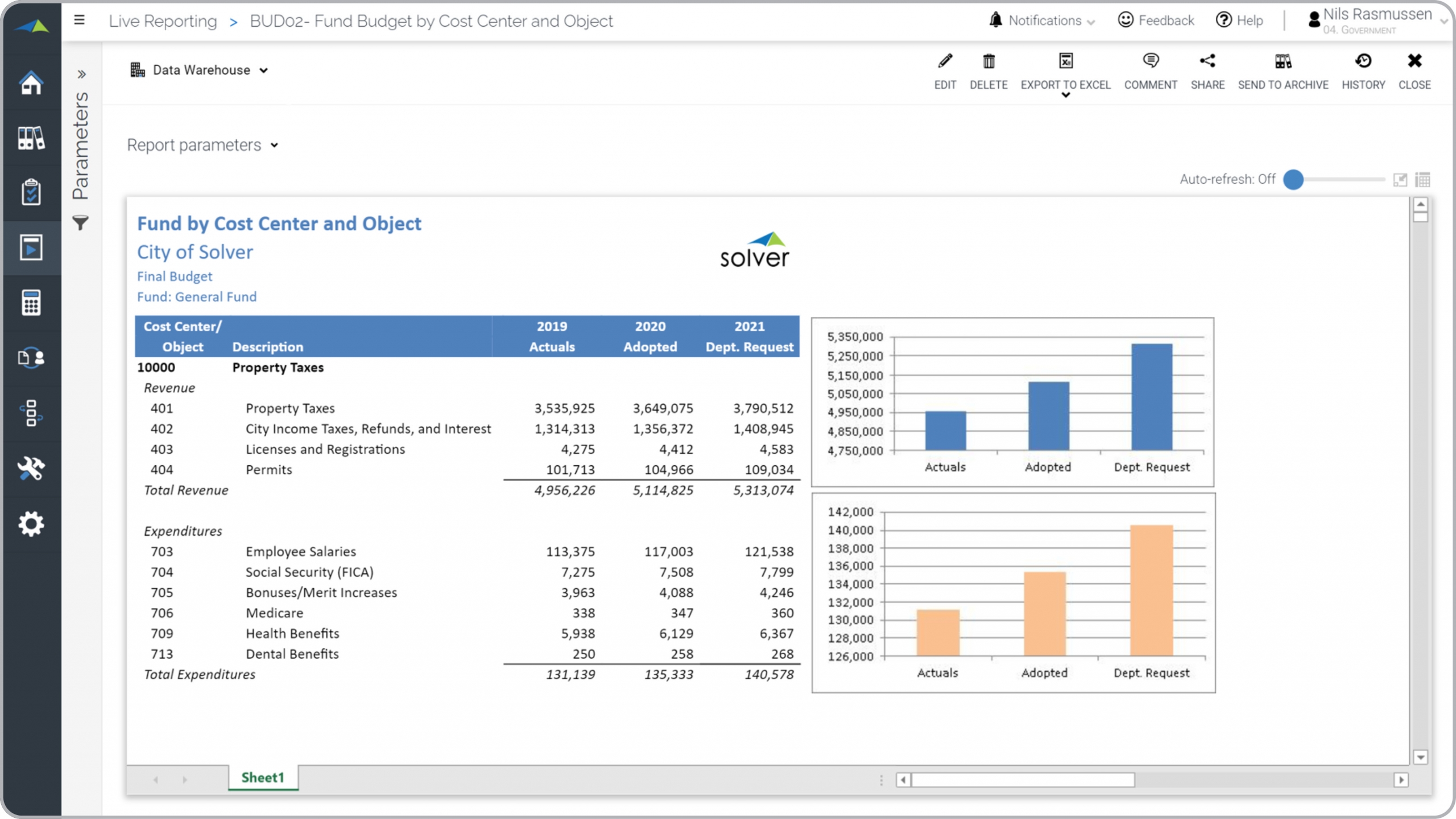Revenue and Expenditure Budget Report by Fund for Public Sector Organizations
What is a
Revenue and Expenditure Budget Report by Fund for Public Sector Organizations
? Revenue and Expense Budget Reports are considered budget review and analysis tools and are used by Financial Managers and Budget Officers to explore approved fund budgets. Some of the main functionality in this type of budget report is that it dynamically displays revenue and expense accounts (object codes) with sub-totals and it can be run for one or many funds at the same time. The columns typically include: 1) Last year's actual results, 2) Current year adopted budget, and 3) Next year's requested budget. The report can also include variances and adjusted/approved budgets. You find an example of this type of budget report below.
Purpose of
Revenue and Expense Budget Reports by Fund Public Sector organizations use Revenue and Expense Budget Reports by Fund to provide a clear understanding of how the budget proposed by departments differs from prior year actual and budgets. When used as part of good business practices in Planning and Accounting departments, a government entity can improve its budget accuracy, and it can reduce the chances that the budget process is slowed down due to unrealistic budget requests.
Example of a
Revenue and Expense Budget Reports by Fun
d Here is an example of a Revenue and Expense Fund Budget Report with graphical variance analysis and actual to budget comparisons.
 You can find hundreds of additional examples
here
Who Uses This Type of
Budget report
? The typical users of this type of budget report are: CFOs, budget officers, controllers.
Other Reports Often Used in Conjunction with
Revenue and Expense Budget Reports by Fund Progressive Planning and Accounting departments sometimes use several different Revenue and Expense Budget Reports by Fund, along with employee budgets, capex budgets, line item detail for revenues and expenses, financial budget dashboards, annual budget report packages and other management and control tools.
Where Does the Data for Analysis Originate From? The Actual (historical transactions) data typically comes from enterprise resource planning (ERP) systems like: Microsoft Dynamics 365 (D365) Finance, Microsoft Dynamics 365 Business Central (D365 BC), Microsoft Dynamics AX, Microsoft Dynamics NAV, Microsoft Dynamics GP, Microsoft Dynamics SL, Sage Intacct, Sage 100, Sage 300, Sage 500, Sage X3, SAP Business One, SAP ByDesign, Acumatica, Netsuite and others. In analyses where budgets or forecasts are used, the planning data most often originates from in-house Excel spreadsheet models or from professional corporate performance management (CPM/EPM) solutions.
What Tools are Typically used for Reporting, Planning and Dashboards? Examples of business software used with the data and ERPs mentioned above are:
You can find hundreds of additional examples
here
Who Uses This Type of
Budget report
? The typical users of this type of budget report are: CFOs, budget officers, controllers.
Other Reports Often Used in Conjunction with
Revenue and Expense Budget Reports by Fund Progressive Planning and Accounting departments sometimes use several different Revenue and Expense Budget Reports by Fund, along with employee budgets, capex budgets, line item detail for revenues and expenses, financial budget dashboards, annual budget report packages and other management and control tools.
Where Does the Data for Analysis Originate From? The Actual (historical transactions) data typically comes from enterprise resource planning (ERP) systems like: Microsoft Dynamics 365 (D365) Finance, Microsoft Dynamics 365 Business Central (D365 BC), Microsoft Dynamics AX, Microsoft Dynamics NAV, Microsoft Dynamics GP, Microsoft Dynamics SL, Sage Intacct, Sage 100, Sage 300, Sage 500, Sage X3, SAP Business One, SAP ByDesign, Acumatica, Netsuite and others. In analyses where budgets or forecasts are used, the planning data most often originates from in-house Excel spreadsheet models or from professional corporate performance management (CPM/EPM) solutions.
What Tools are Typically used for Reporting, Planning and Dashboards? Examples of business software used with the data and ERPs mentioned above are:
- Native ERP report writers and query tools
- Spreadsheets (for example Microsoft Excel)
- Corporate Performance Management (CPM) tools (for example Solver)
- Dashboards (for example Microsoft Power BI and Tableau)
Corporate Performance Management (CPM) Cloud Solutions and More Examples
July 8, 2021
TAGS:
Reporting,
Solver,
local,
report writer,
Microsoft,
template,
practice,
Acumatica,
Netsuite,
Finance,
public,
comparison,
planning,
GP,
Government,
Business Central,
state,
excel,
ax,
expense,
forecast,
Budget,
Dynamics 365,
budgeting,
sources and uses,
revenue,
Cloud,
Software,
adopted,
Tableau,
SAP,
example,
best,
Sage,
BC,
D365,
fund,
NAV,
Intacct,
monthly,
county,
city,
CPM,
report,
sector,
SL,
Management,
dynamics,
Power BI,
financial report,
budget report

 You can find hundreds of additional examples
You can find hundreds of additional examples